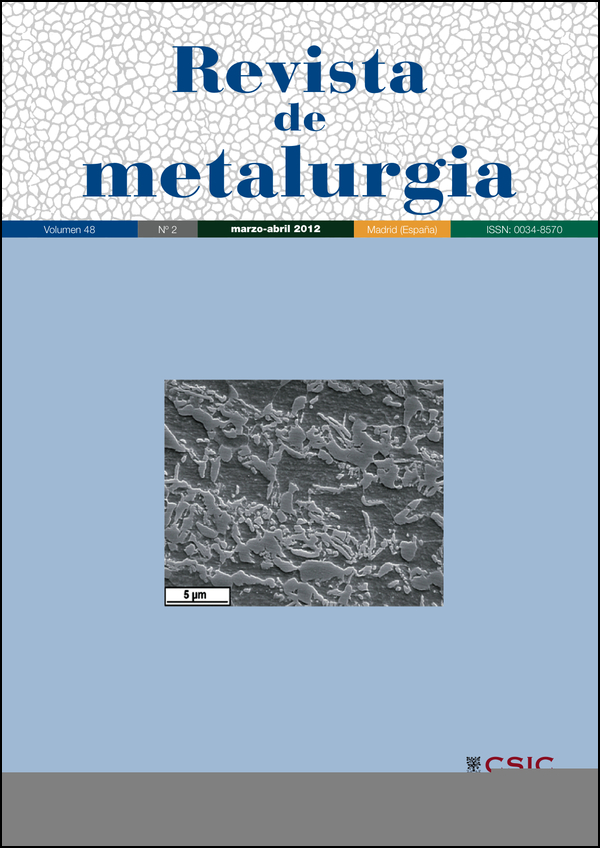Study of phase separation in liquid-liquid systems using LIX 984N in organic phase
DOI:
https://doi.org/10.3989/revmetalm.1155Keywords:
LIX 984N, Phase separation, Liquid-liquid dispersion, Sedimentation, CoalescenceAbstract
In this work we studied the sedimentation and coalescence phenomena in liquid-liquid dispersion without chemical reaction, the aqueous electrolyte consisted of 0.25 M sodium sulfate and an organic phase characteristic organic extractant for copper (LIX 984N) diluted in a commercial solvent (Shellsol 24 AR). The phenomena that dominate the phase separation have been studied by several researchers, which proposed a number of models to predict sedimentation and coalescence profiles. In this work we applied a semi-empirical model to describe the phenomena involved, varying the following experimental conditions: percentage of extractant in organic phase (5 - 30 % v / v), continuous phase (aqueous and organic), time and stirring speed (30 - 1800 s and 400 - 1200 rpm respectively). The main results show that from the 800 rpm of agitation this variable has no influence on primary breakup time, in the same way for 180 seconds of stirring produces the same effect. The fraction of dispersed phase in the packing zone found was 0.74. For higher levels of percentage of extractant in organic phase increased the phase separation time as when the organic phase was used as the continuous phase relative to the aqueous phase. We found a partial adjustment of the experimental data in relation to the simulated values , which is attributable to two factors: the initial inertia of the system once the agitation stopped and the existence of different times of inflection points of the curves of sedimentation and coalescence. In the different articles found in literature assume that the above phenomena occur simultaneously.
Downloads
References
[1] D. Flett, J. Organomet. Chem. 690 (2005) 2.426-2.438.
[2] S. Lin y R. Juang, Water Res. 36 (2002) 3.611- 3.619.
[3] G. Kordosky, M. Virnig y B. Boley, Tsinghua Sci. Technol. 11 (2006) 160-164. http://dx.doi.org/10.1016/S1007-0214(06)70170-5
[4] J. Ocaranza, Anuario de estadísticas del cobre y otros minerales, COCHILCO, Santiago, Chile, 2010, pp. 16-19.
[5] T. Frising, C. Noïk, C. Dalmazzone y J. Disper, Sci. Technol. 27 (2006) 1.035-1.057.
[6] R. Reeve y J. Godfrey, Trans. IChemE 80 (2002) 864-871. http://dx.doi.org/10.1205/026387602321143408
[7] S. Jeelani, K. Panoussopoulos y S. Hartland, Ind. Eng. Chem. Res. 38 (1999) 493-501. http://dx.doi.org/10.1021/ie980436b
[8] A. Khakpay, H. Abolghasemi y A. Salimi-Khorshidi, Chem. Eng. Process 48 (2009) 1.105-1.111.
[9] J. Spence y J. Masliyah, Can. J. Chem. Eng. 67 (1989) 924-928. http://dx.doi.org/10.1002/cjce.5450670609
[10] A. Kumar y S. Hartland, Ind. Eng. Chem. Res. 34 (1996) 3.925-3.940.
[11] J. Golob y R. Modic, Trans. IChem. 55 (1977) 207-211.
[12] S. Hartland y S. Jeelani, Chem. Eng. Sci. 43 (1988) 2.421-2.429.
[13] C. Nadiv y R. Semiat, Ind. Eng. Chem. Res. 34 (1995) 2.427-2.435.
[14] S. Jeelani y S. Hartland, Ind. Eng. Chem. Res. 37 (1998) 547-554. http://dx.doi.org/10.1021/ie970545a
[15] G. Yu y Z. Mao, Chem. Eng. Technol. 27 (2004) 407-413. http://dx.doi.org/10.1002/ceat.200401884
[16] A. Kumar y S. Hartland, Can. J. Chem. Eng. 63 (1985) 368-376. http://dx.doi.org/10.1002/cjce.5450630303
Downloads
Published
How to Cite
Issue
Section
License
Copyright (c) 2012 Consejo Superior de Investigaciones Científicas (CSIC)

This work is licensed under a Creative Commons Attribution 4.0 International License.
© CSIC. Manuscripts published in both the printed and online versions of this Journal are the property of Consejo Superior de Investigaciones Científicas, and quoting this source is a requirement for any partial or full reproduction.All contents of this electronic edition, except where otherwise noted, are distributed under a “Creative Commons Attribution 4.0 International” (CC BY 4.0) License. You may read here the basic information and the legal text of the license. The indication of the CC BY 4.0 License must be expressly stated in this way when necessary.
Self-archiving in repositories, personal webpages or similar, of any version other than the published by the Editor, is not allowed.


















